October 23, 2024 · 10 min read
How to Track and Manage Action Items from Project Meetings Effectively

Shaimaa Badawi
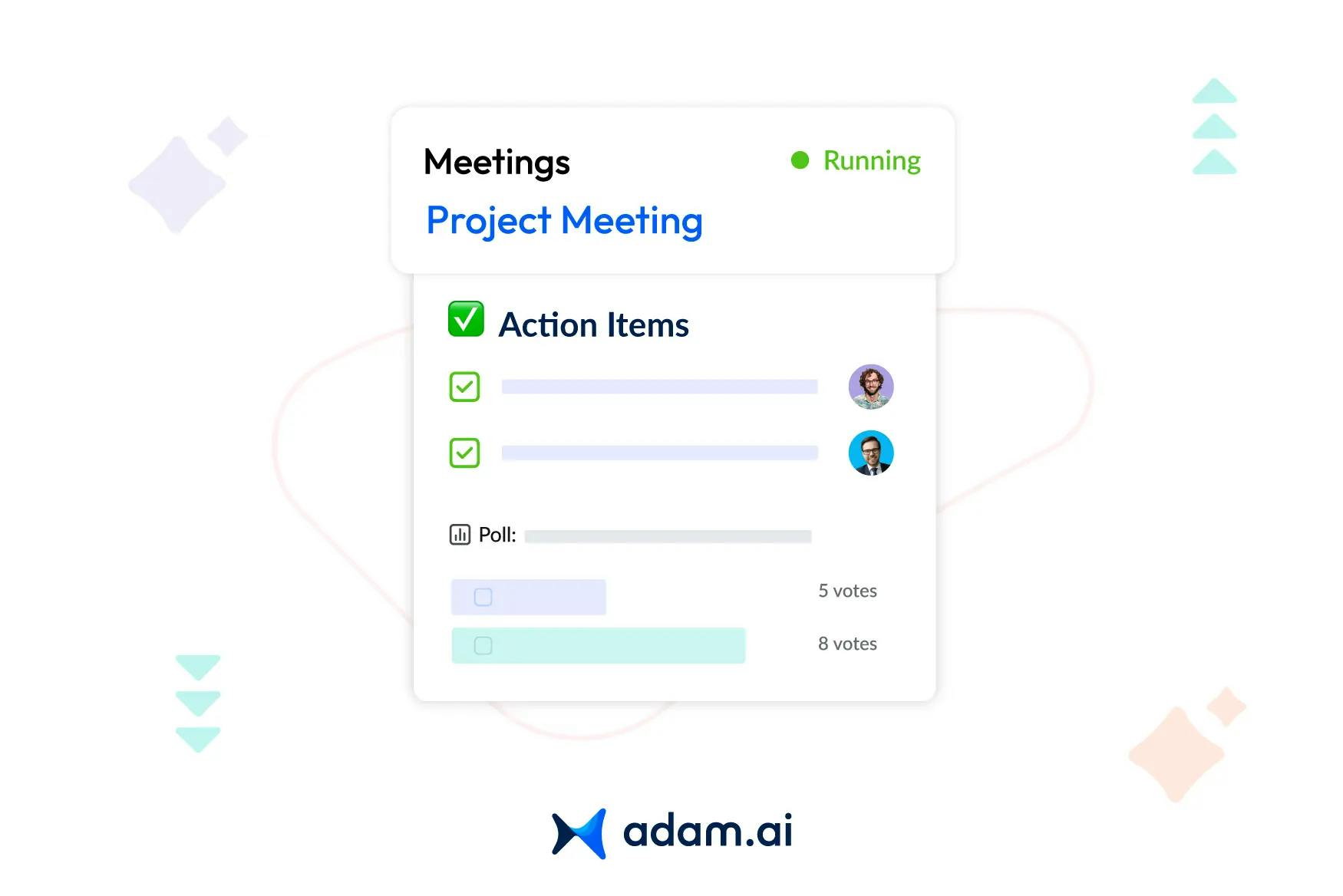
Turning meeting discussions into actionable outcomes is a challenge for many teams, but effective action item management can make all the difference. In this article, we’ll explore what action items are, the common challenges in tracking them, best practices for assigning and following up, and how modern tools can help your team stay organized, accountable, and productive.
What are action items in project meetings, and why are they important?
Action items in project meetings are specific tasks or responsibilities assigned to individuals or teams to ensure the execution of decisions made during the meeting. These items serve as actionable steps that directly contribute to achieving the project's objectives and advancing team goals. Typically, action items are recorded in meeting notes or minutes, detailing what needs to be done, who is responsible, and when the task is due.
The importance of action items lies in their ability to transform meeting discussions into measurable outcomes. They provide clarity, accountability, and structure to ensure follow-through on decisions. Clear action items prevent miscommunication, align team members on priorities, and set deadlines for progress. By assigning ownership and tracking tasks, action items help maintain momentum, mitigate risks, and improve overall project efficiency.
For example, assigning an action item like "Prepare a project timeline draft by [specific date]" ensures clarity on responsibilities and deadlines, holding the assignee accountable while keeping the team focused on collective goals. Effective management of action items fosters a productive meeting culture and drives projects forward systematically.
What are the common challenges in tracking and managing action items?
Tracking and managing action items often come with several challenges that can hinder project progress and team efficiency. These challenges typically revolve around unclear task definitions, poor accountability, and inadequate follow-up mechanisms.
1. Vague or ambiguous action items
When action items are not clearly defined, team members may struggle to understand what is expected of them. This lack of clarity can lead to confusion, delays, or incomplete work, as assignees waste time interpreting the task instead of executing it effectively.
2. Lack of accountability
Without assigning specific individuals or teams to each action item, tasks often go unclaimed and uncompleted. Accountability ensures that someone takes ownership of the task and drives it to completion, preventing it from being overlooked.
3. Missed deadlines
If due dates are unrealistic, or if deadlines are not firmly set and communicated, action items may fall through the cracks. Action items require firm, achievable deadlines to maintain momentum and ensure timely execution.
4. Inconsistent tracking
Scattered tools, disconnected systems, or poor organization can cause action items to be lost in the shuffle. A centralized tracking system is essential to monitor progress, prioritize tasks, and keep everything visible to all stakeholders.
5. Poor follow-up
Even well-documented action items can falter without consistent follow-up. Regular check-ins and updates are crucial to address obstacles, track progress, and maintain accountability throughout the project lifecycle.
6. Changing priorities
Shifting priorities can disrupt the focus on action items. Open communication and adaptability are necessary to realign efforts and ensure critical action items are not deprioritized or forgotten.
How can you effectively assign action items during project meetings?
Effectively assigning action items during project meetings is crucial to ensure that discussions translate into tangible outcomes and team members remain aligned on their responsibilities. Here's how you can do it:
1. Clearly define the action item
Start by ensuring the task is specific and actionable. Each action item should outline what needs to be done, why it’s important, and the desired outcome. Use precise language to eliminate ambiguity and provide context to help the assignee understand the bigger picture.
2. Assign a responsible person
Every action item should have a designated owner. This individual is accountable for completing the task and serves as the point of contact for any questions or updates. Assigning responsibility directly ensures accountability and avoids confusion about who is in charge.
3. Set realistic deadlines
Establish firm but achievable deadlines for each action item. Deadlines should account for the task's complexity, the assignee’s workload, and project dependencies. A clear timeline creates urgency while allowing for effective time management.
4. Provide necessary resources
Make sure the assignee has access to all the tools, information, or support required to complete the task. Whether it’s relevant files, software, or team collaboration, enabling access ensures the task can be executed without unnecessary delays.
5. Use action-oriented language
When describing tasks, start with action verbs to make the deliverable clear and actionable. For example, say “Prepare a project timeline draft by [specific date]” instead of “Work on the timeline.”
6. Confirm understanding
Before moving on, confirm that the assignee fully understands their responsibilities, the deadline, and any expectations. Encourage questions and clarify any uncertainties to ensure alignment and commitment.
7. Document and share assignments
Capture the action items in meeting notes or a centralized system and share them with all attendees. This reinforces accountability and provides a reference point for follow-up discussions. Tools like meeting management software can help streamline this process and keep everyone aligned.
What are the best practices for tracking action items after a meeting?
Tracking action items after a meeting is essential to ensure that commitments made during discussions are followed through, driving projects forward and maintaining accountability. Let's find out how:
1. Centralize action item tracking
Use a single platform or tool to organize and monitor all action items. Centralized tracking ensures that tasks remain visible to the team and prevents them from being scattered across different tools, emails, or notes. This approach fosters clarity and easy access to task updates.
2. Prioritize tasks
Categorize action items based on urgency and importance. Prioritizing tasks helps team members focus on what needs immediate attention while ensuring less critical items are not overlooked.
3. Set clear milestones and deadlines
Establish deadlines and, where applicable, milestones for each action item. Clear timeframes provide structure and keep the team on track, preventing delays and missed objectives.
4. Regularly update progress
Encourage team members to update the status of their tasks in the tracking system. Frequent updates ensure transparency, allow for quick identification of stalled tasks, and help address issues promptly.
5. Conduct follow-ups
Schedule periodic check-ins to review progress on action items. These meetings provide an opportunity to resolve roadblocks, realign priorities, and ensure that tasks are on track for completion.
6. Foster open communication
Encourage team members to communicate any challenges, changes in priorities, or need for resources as soon as they arise. This proactive approach helps to mitigate risks and ensures smooth task execution.
7. Integrate automation where possible
Leverage task management tools that offer automated reminders and status updates. Automation reduces manual tracking efforts and ensures that nothing slips through the cracks.
8. Reflect and adjust
At the completion of action items, review what went well and what could be improved. Document lessons learned to refine processes for tracking future action items and enhance team efficiency.
Tracking action items effectively after a meeting ensures accountability, clarity, and progress, keeping the team aligned and projects moving forward.
Why is automated follow-up essential for effective task management?
Automated follow-ups are a game-changer for task management, ensuring that action items are consistently tracked, deadlines are met, and team productivity is maximized. Here's why automation is essential:
1. Reduces human error
Automated follow-ups minimize the risk of forgetting important tasks or deadlines. By using reminders and notifications, teams can stay on top of their responsibilities without relying solely on memory or manual tracking.
2. Enhances accountability
When follow-ups are automated, task owners receive consistent reminders about their assigned responsibilities. This creates a system of accountability, ensuring that tasks are not overlooked or deprioritized.
3. Saves time and effort
Automation streamlines the follow-up process, reducing the time spent on manually checking in with team members. This allows project managers and teams to focus on strategic priorities rather than administrative tasks.
4. Improves visibility
Automated systems often integrate with task management tools, providing real-time updates on the progress of action items. This transparency helps teams stay aligned and enables managers to address issues proactively.
5. Encourages timely completion
Consistent reminders keep tasks at the forefront of team members’ minds, creating a sense of urgency to meet deadlines. This fosters a culture of efficiency and ensures tasks are completed on schedule.
6. Supports scaling efforts
For large teams or complex projects, managing follow-ups manually can become unmanageable. Automation ensures that follow-ups are scalable, keeping all team members informed and aligned regardless of project size.
What are the long-term benefits of managing action items effectively in projects?
Managing action items effectively delivers lasting advantages that go beyond immediate project outcomes, setting teams up for long-term success. Here's what you stand to gain:
- Improved team accountability: When responsibilities are clearly assigned and tracked, team members are more likely to deliver on their commitments consistently.
- Enhanced project efficiency: Streamlined management of action items reduces delays and ensures tasks are completed on time.
- Better resource allocation: Tracking action items effectively provides visibility into workload distribution and task progress.
- Strengthened communication: Everyone stays informed about responsibilities and deadlines, reducing misunderstandings and improving collaboration.
- Increased stakeholder confidence: When action items are well-managed, stakeholders see consistent progress and timely delivery of results.
- Higher quality outcomes: By maintaining focus and accountability for each action item, teams can ensure thorough execution of tasks.
How can task management tools streamline action item follow-ups?
Task management tools simplify the follow-up process by automating repetitive tasks, improving visibility, and enhancing team collaboration, ultimately driving better results.
Centralized task tracking
Task management tools consolidate all action items in one place, providing a clear overview of responsibilities, deadlines, and progress. This centralization eliminates the need to search through scattered notes or emails, saving time and reducing confusion.
Automated reminders and notifications
These tools send timely reminders and updates to task owners, ensuring that no action item is forgotten or delayed. Automated notifications help maintain momentum and accountability without manual follow-ups.
Real-time collaboration
With features like shared dashboards and integration with communication platforms, task management tools enable seamless collaboration. Team members can update their progress, share feedback, and address roadblocks in real time, keeping everyone aligned.
Priority and deadline management
Task management tools allow users to set priorities and deadlines for each action item. This ensures that critical tasks receive the attention they need and that all team members stay aware of upcoming deadlines.
Integration with other tools
Many task management solutions integrate with project management software, calendars, and email platforms. This integration streamlines workflows and ensures that action items are visible across all relevant systems.
Progress monitoring and reporting
These tools provide visual progress indicators, such as Gantt charts or Kanban boards, to track the status of action items. Managers can quickly assess the overall project health and identify any tasks that require immediate attention.
How can adam.ai help teams track and manage action items from meetings?
adam.ai is an all-in-one meeting management platform designed to streamline the tracking and management of action items arising from meetings. Here's how it enhances team efficiency:
- Automated action item identification: adam.ai's AI meeting assistant, iAdam, transcribes meetings and highlights key points, transforming them into actionable items. This automation ensures that no critical task is overlooked.
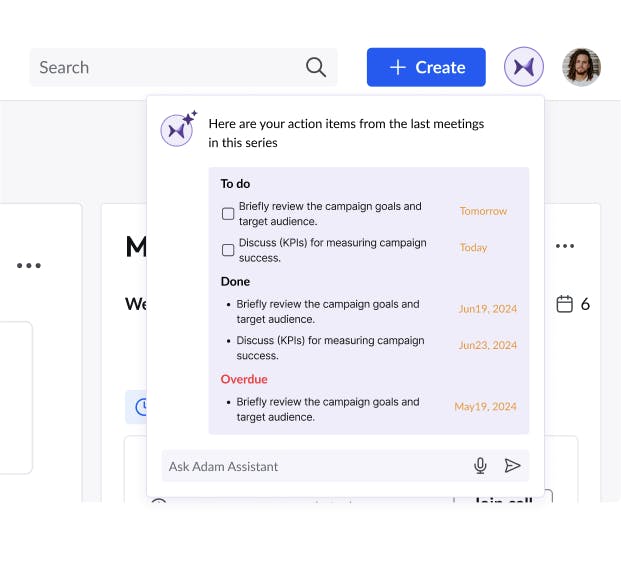
- Centralized action management: The platform offers a dedicated actions page where teams can assign tasks, set deadlines, and monitor progress. This centralized system enhances accountability and provides a clear overview of responsibilities.
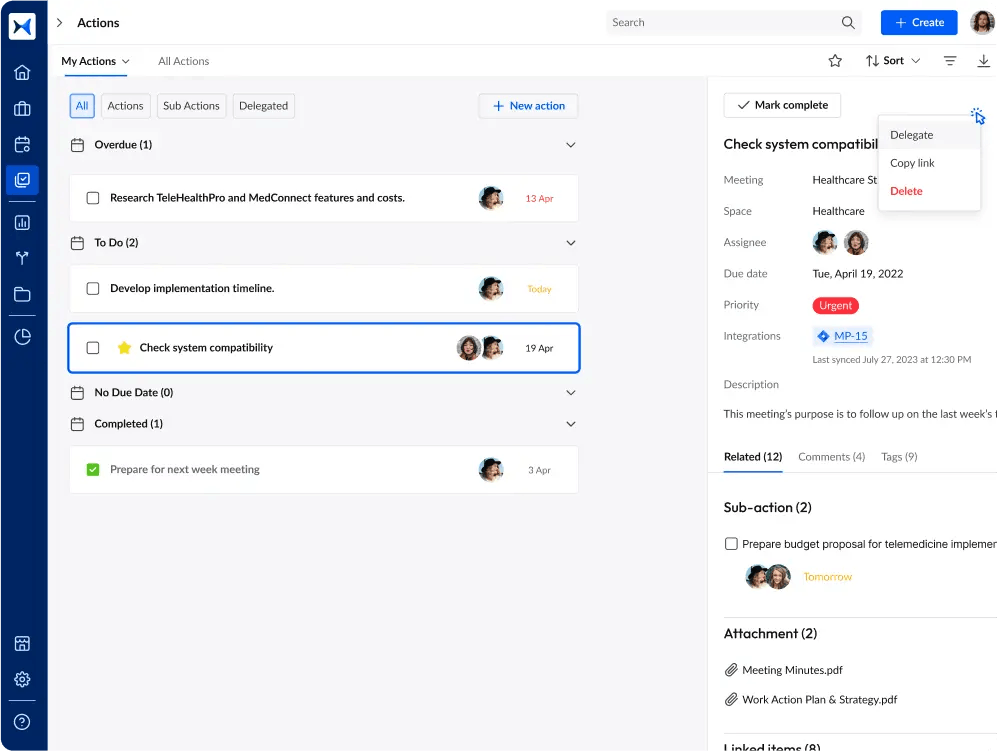
- Seamless integration with project management tools: adam.ai integrates with tools like Jira, allowing users to send action items directly to their project boards. This integration ensures continuity between meeting discussions and project execution.
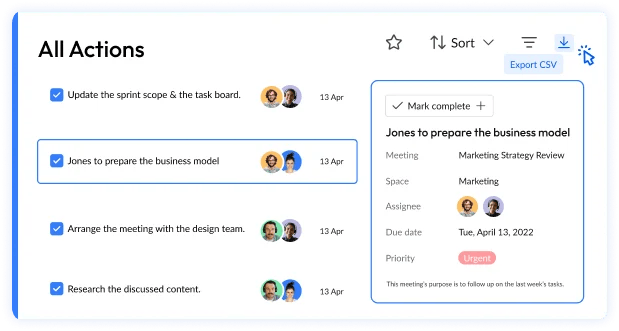
- Comprehensive reporting and analytics: adam.ai provides insightful dashboards and reports on meeting outcomes and productivity. These analytics help teams monitor progress, identify bottlenecks, and make informed decisions.
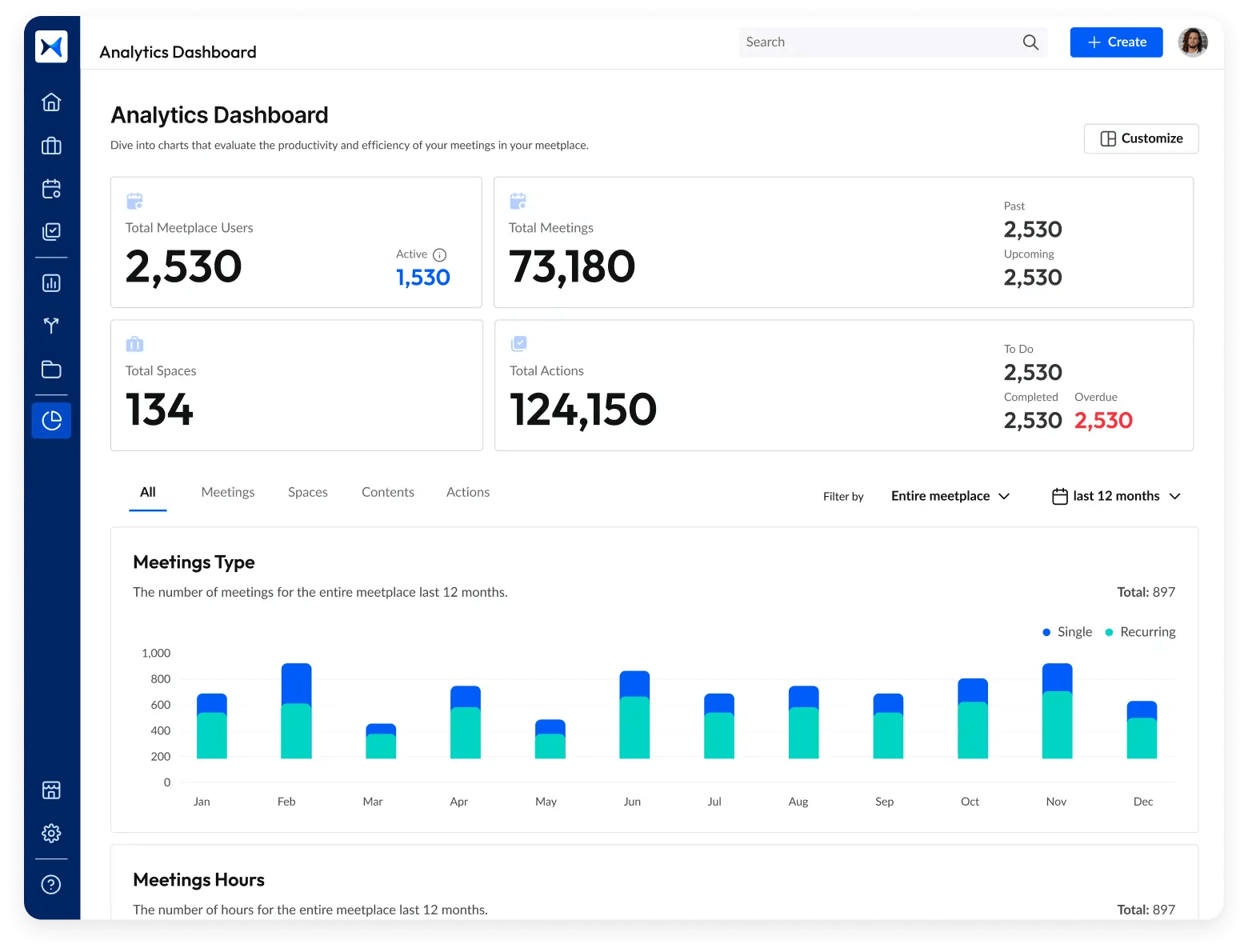
Transform how you conduct critical meetings—From meticulous preparation to effective execution and insightful follow-up, adam.ai integrates comprehensive analytics, full customization, and intuitive interfaces with powerful meeting management tools.
Easy onboarding. Enterprise-grade security. 24/7 dedicated support.
The bottom line
Mastering the art of tracking and managing action items is key to turning meeting goals into tangible results. By defining clear tasks, leveraging automation, and using platforms like adam.ai, teams can streamline workflows, improve accountability, and achieve project milestones with greater efficiency.
And while there may be multiple solutions available, here is why adam.ai is the meeting management software platform you can trust:
- adam.ai is one of Atlassian Ventures' portfolio companies.
- In the meeting management software category on G2, adam.ai has been ranked a leader and a high performer for successive quarters in the past years.
- adam.ai has been included in the Forrester Report in the AI-enabled meeting technology landscape.
- adam.ai is trusted and used by powerful teams and organizations worldwide for all types of critical meetings, like board, committee, project management, and business development meetings.
- And most importantly, adam.ai integrates with your existing workflow, is SOC2 compliant, provides dedicated support and success, and has a free trial option.
Subscribe to adam.ai blog
Stay ahead with the latest insights—get our newest blog posts, tips, and updates sent straight to your inbox.